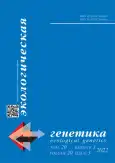Использование генов R-nj, B1, Pl1 для улучшения маркерных свойств в селекции гаплоиндукторов кукурузы
- Авторы: Лю С.1, Ульянов А.В.2, Хатефов Э.Б.2
-
Учреждения:
- Научно-исследовательский институт кукурузы, Ляонинская академия сельскохозяйственных наук
- Федеральный исследовательский центр Всероссийский институт генетических ресурсов растений им. Н.И. Вавилова
- Выпуск: Том 20, № 3 (2022)
- Страницы: 193-202
- Раздел: Генетические основы эволюции экосистем
- Статья получена: 30.05.2022
- Статья одобрена: 14.09.2022
- Статья опубликована: 28.10.2022
- URL: https://journals.eco-vector.com/ecolgenet/article/view/108374
- DOI: https://doi.org/10.17816/ecogen108374
- ID: 108374
Цитировать
Полный текст
Аннотация
Исследовано создание гаплоиндукторных линий с использованием различных методов тестирования гаплоиндукторной способности из генетической коллекции кукурузы ВИР. В результате проведенной работы созданы гаплоиндукторные линии кукурузы Ляоюй № 1, Ляоюй № 2, Ляоюй № 3 и Ляоюй № 4 с частотой гаплоиндукции 6,85, 7,53, 6,66 и 6,03 % соответственно с высокой степенью выраженности антоциановых маркеров, контролируемых генами R1-nj, В1, Pl1.
Ключевые слова
Полный текст
Об авторах
Синьфань Лю
Научно-исследовательский институт кукурузы, Ляонинская академия сельскохозяйственных наук
Email: xinfangliu2002@126.com
магистр, младший научный сотрудник
Тайвань, Шэньян, ЛяонинАлексей Владимирович Ульянов
Федеральный исследовательский центр Всероссийский институт генетических ресурсов растений им. Н.И. Вавилова
Email: krasnixin56@gmail.com
лаборант-исследователь
Россия, Санкт-ПетербургЭдуард Балилович Хатефов
Федеральный исследовательский центр Всероссийский институт генетических ресурсов растений им. Н.И. Вавилова
Автор, ответственный за переписку.
Email: haed1967@rambler.ru
ORCID iD: 0000-0001-5713-2328
SPIN-код: 7929-8148
д-р биол. наук, вед. научн. сотр.
Россия, Санкт-ПетербургСписок литературы
- Chase S.S. Monoploid frequencies in a commercial double cross hybrid maize, and its component single cross hybrids and inbred lines // Genetics. 1949. Vol. 34, No. 1. P. 328–332. doi: 10.1093/genetics/34.3.328
- Асадова Г.М., Ульянов А.В., Карлов М.В., Хатефов Э.Б. Перспективы использования гаплоиндукторов в селекции кукурузы // Биотехнология и селекция растений. 2020. Т. 3, № 2. С. 16–29. doi: 10.30901/2658-6266-2020-2-o3
- Mayor P., Bernardo R. Doubled haploids in commercial maize breeding: one-stage and two-stage selection versus marker-assisted recurrent selection // Maydica. 2007. Vol. 54. P. 439–448.
- Шацкая О.А. Создание гаплоиндукторов кукурузы: три цикла отбора на высокую частоту индукции матроклинных гаплоидов // Сeльскохозяйственная биология. 2010. Т. 45, № 5. С. 79–86.
- Хохлов С.С., Тырнов В.С., Гришина Е.В., Давоян Н.И. Гаплоидия и селекция. Москва: Наука, 1976. 221 с.
- Тырнов В.С., Завалишина А.Н. Индукция высокой частоты возникновения матроклинных гаплоидов у кукурузы // Доклады АН СССР. 1984. Т. 276, № 3. C. 735–738.
- Coe E.H. A line of maize with high haploid frequency // Am Nat. 1959. Vol. XCIII, No. 873. P. 381–382. doi: 10.1086/282098
- Chumak M.V. The use of haploid in breeding maize // Proceedings of the tenth meeting of the maize and sorghum section of EUCARPIA; Sept 17–19, 1979; Varna.
- Zavalishina A.N., Tyrnov V.S. Induction of matroclinal haploidy in maize in vivo // XIII Eucarpia Congress, Reproductive Biology and Plant Breeding. Angers, France. 1992. P. 221–222.
- Rotarenco V., Dicu G., State D., Fuia S. New inducers of maternal haploids in maize // Maize Genet Coop Newsletter. 2010. Vol. 84. P. 21–22.
- Prigge V., Schipprack W., Mahuku G., et al. Development of in vivo haploid inducers for tropical maize breeding programs // Euphytica. 2012. Vol. 185. P. 481–490. doi: 10.1007/s10681-012-0657-5
- Xu X., Li L., Dong X., et al. Gametophytic and zygotic selection leads to segregation distortion through in vivo induction of a maternal aploid in maize // J Exp Bot. 2013. Vol. 64, No. 4. P. 1083–1096. doi: 10.1093/jxb/ers393
- Liu Z.Z., Song T.M. Breeding and identification of high frequency parthenogenetic haploid induction lines in maize // Acta Agronomica Sinica. 2000. Vol. 26, No. 5. P. 570–574.
- Cai Z., Xu G.L., Liu X.H., et al. The breeding of JAAS3-Haploid inducer with high frequency parthenogenesis in maize // Journal of Maize Sciences. 2007. Vol. 15, No. 1. P. 1–4.
- Yue Y.H., Lu M., Zhang J.X., et al. Breeding of maize haploid high frequency induction line Jiyou // Crop. 2017. Vol. 101, No. 3. P. 35–38.
- Röber F.K., Gordillo G.A., Geiger H.H. In vivo haploid induction in maize — performance of new inducers and significance of doubled haploid lines in hybrid breeding // Maydica. 2005. Vol. 50. P. 275–283.
- Chen S., Song T. Identification haploid with high oil xenia effect in maize // Acta Agronomica Sinica. 2003. Vol. 29. P. 587–590.
- Lasharmes P., Bekert M. Genetic control of maternal haploidy in maize (Zea mays L.) and selection of haploid inducing lines // Theoretical and Applied Genetics. 1988. Vol. 76. P. 405–410. doi: 10.1007/BF00265341
- Chalyk S.T. Properties of maternal haploid maize plants and potential application to maize breeding // Euphytica. 1994. Vol. 79. P. 13–18.
- Melchinger A.E., Schipprack W., Würschum T., et al. Rapid and accurate identification of in vivo-induced haploid seeds based on oil content in maize // Sci. Rep. 2013. Vol. 3. P. 2129
- Gayen P., Madan J.K., Kumar R., Sarkar K.R. Chromosome doubling in haploids through colchicine // Maize Genet. Coop. Newslett. 1994. Vol. 68. P. 65
Дополнительные файлы


















